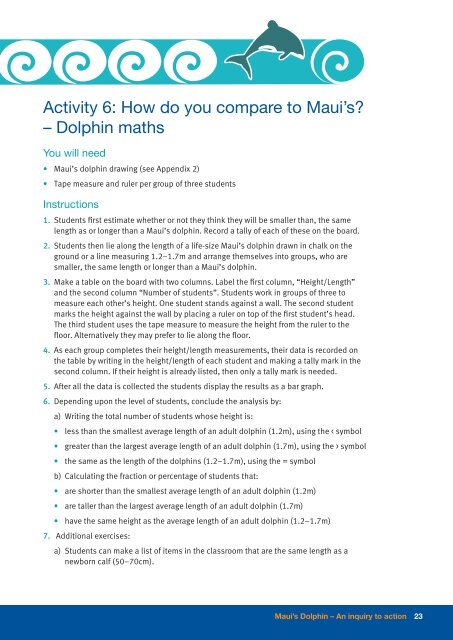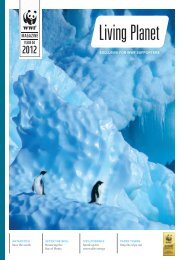Maui’s Dolphin –
Maui's Dolphin â - Panda - WWF
Maui's Dolphin â - Panda - WWF
- No tags were found...
You also want an ePaper? Increase the reach of your titles
YUMPU automatically turns print PDFs into web optimized ePapers that Google loves.
Activity 6: How do you compare to <strong>Maui’s</strong>?<br />
<strong>–</strong> <strong>Dolphin</strong> maths<br />
You will need<br />
• <strong>Maui’s</strong> dolphin drawing (see Appendix 2)<br />
• Tape measure and ruler per group of three students<br />
Instructions<br />
1. Students first estimate whether or not they think they will be smaller than, the same<br />
length as or longer than a <strong>Maui’s</strong> dolphin. Record a tally of each of these on the board.<br />
2. Students then lie along the length of a life-size <strong>Maui’s</strong> dolphin drawn in chalk on the<br />
ground or a line measuring 1.2<strong>–</strong>1.7m and arrange themselves into groups, who are<br />
smaller, the same length or longer than a <strong>Maui’s</strong> dolphin.<br />
3. Make a table on the board with two columns. Label the first column, “Height/Length”<br />
and the second column “Number of students”. Students work in groups of three to<br />
measure each other’s height. One student stands against a wall. The second student<br />
marks the height against the wall by placing a ruler on top of the first student’s head.<br />
The third student uses the tape measure to measure the height from the ruler to the<br />
floor. Alternatively they may prefer to lie along the floor.<br />
4. As each group completes their height/length measurements, their data is recorded on<br />
the table by writing in the height/length of each student and making a tally mark in the<br />
second column. If their height is already listed, then only a tally mark is needed.<br />
5. After all the data is collected the students display the results as a bar graph.<br />
6. Depending upon the level of students, conclude the analysis by:<br />
a) Writing the total number of students whose height is:<br />
• less than the smallest average length of an adult dolphin (1.2m), using the < symbol<br />
• greater than the largest average length of an adult dolphin (1.7m), using the > symbol<br />
• the same as the length of the dolphins (1.2<strong>–</strong>1.7m), using the = symbol<br />
b) Calculating the fraction or percentage of students that:<br />
• are shorter than the smallest average length of an adult dolphin (1.2m)<br />
• are taller than the largest average length of an adult dolphin (1.7m)<br />
• have the same height as the average length of an adult dolphin (1.2<strong>–</strong>1.7m)<br />
7. Additional exercises:<br />
a) Students can make a list of items in the classroom that are the same length as a<br />
newborn calf (50<strong>–</strong>70cm).<br />
<strong>Maui’s</strong> <strong>Dolphin</strong> <strong>–</strong> An inquiry to action<br />
23






